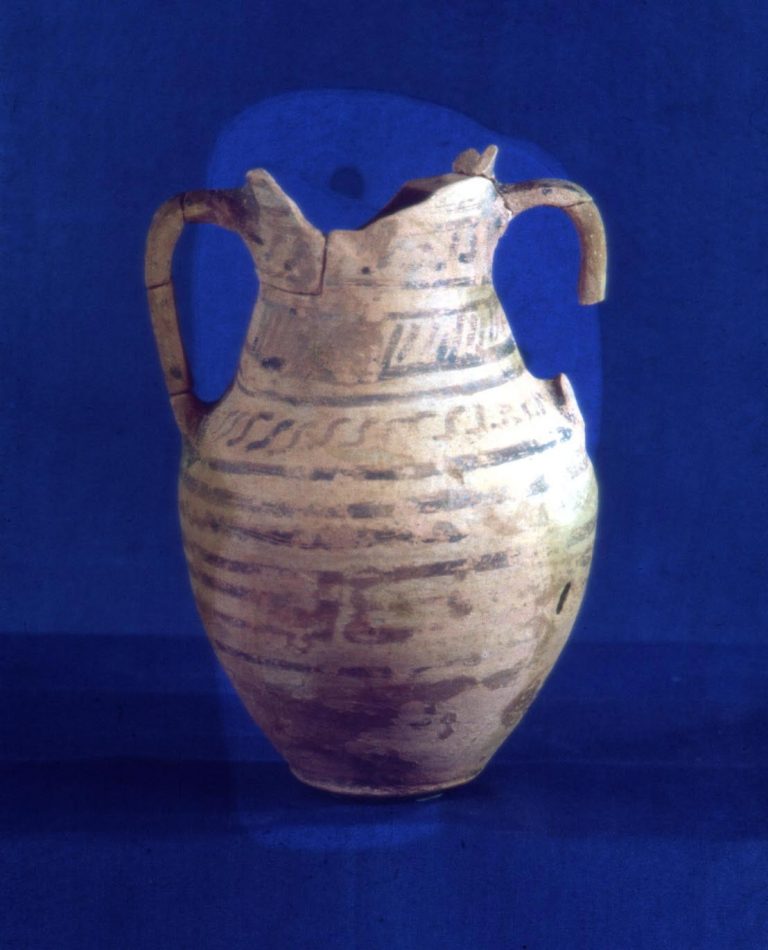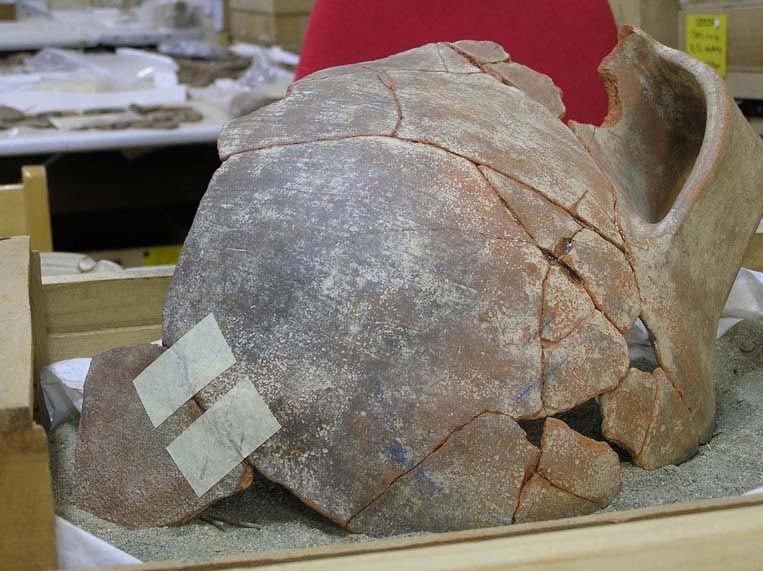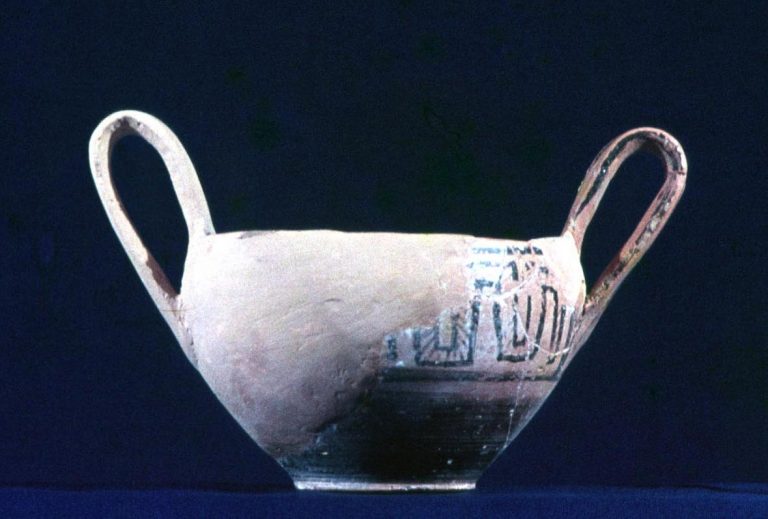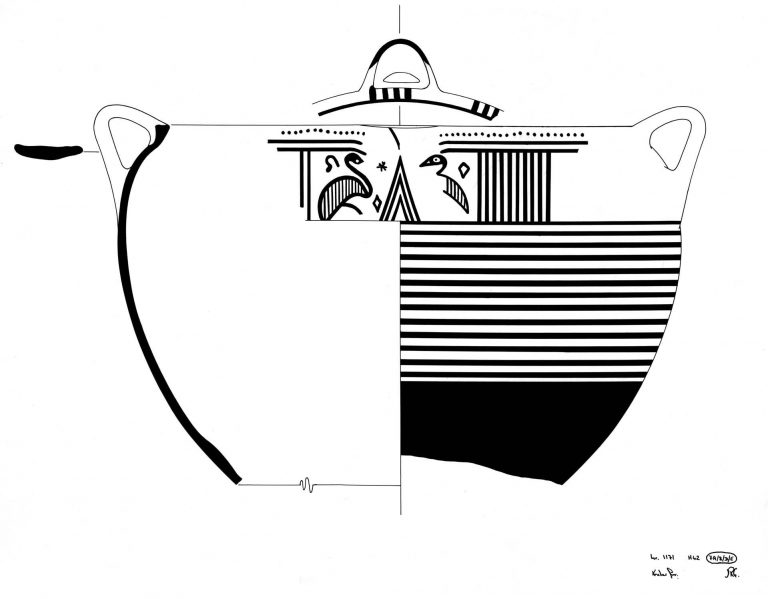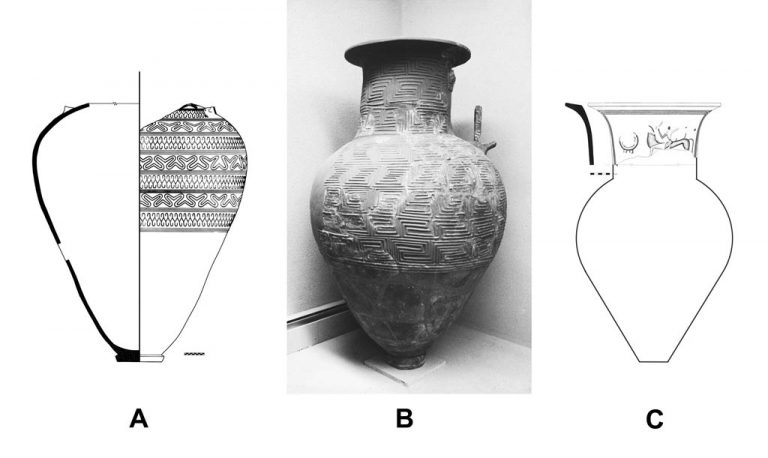Artefacts found at Zagora
This is a selected list of artefacts, or terminology related to artefacts, of the kind that have been found at Zagora. (The plural is usually indicated by adding ‘e’ or ‘i’ if the word ends in ‘a’ – eg, amphora/amphorae or chytra/chytrai; or replacing the final ‘s’ if the word ends in ‘s’ with an ‘i’ – eg, pithos/pithoi.)
Amphora – An amphora is a two-handled vessel with a relatively narrow neck well suited for the storage and transport of a wide range of goods. It occurs in many sizes. The shape was made in fine and coarse wares, and the former may bear ornate painted decoration. Other than in the home and in sanctuary contexts amphorae were also used in the funerary sphere, often to hold the cremated remains of the dead. At some point in the middle of the eighth century BCE, very large, and ornately decorated, amphorae were used in some Athenian cemeteries to mark the graves of elite females. By the Classical period, table amphorae are considered part of the symposium set as the container of the undiluted wine before it is decanted into the krater. Towards the latter part of the eighth century BCE, large plain transport amphorae appear – an indication that the movement of goods was increasing in volume at this time.
Artefact – a movable object that has been manufactured or altered by humans.
Cauldron – a large pot used predominantly for boiling.
Ceramic – objects made from clay that are hardened by firing at high temperatures. Some of the earliest ceramics were pottery items.
Chytra – a generic term for cooking pot in ancient Greek. In archaeology the term is primarily used to describe one or two handled deep stewing pots. At Zagora the most common cooking pot shape is that of a flat bottomed ovoid jug with a defined neck, slightly out-turned rim and a vertical handle. They are common in all sizes from less than a litre up to 5 litres. They often have smoke smudging on the belly and base on the side opposite the handle – suggestive of having been placed in the coals at the edge of a hearth, with coals heaped up over the belly. This shape is ideal for slow cooking as the egg-shaped body helps the heat circulate, keeping the contents agitated – in other words self stirring, without too much liquid evaporating. There is also one very impressive example of this shape with a much larger capacity (over 18 litres), which may have been used for making bulk preserves or for communal feasting. The second most common shape is a wider version with one or two handles, no defined neck and a diameter greater than the height, i.e. cup shaped. Two examples of this shape have smoke smudging across the base and all the way around the lower walls, which suggests that they were either set completely into heaped coals or were held above them on cooking stands. These vessels are suited to more rapid boiling or frying.
Coarseware pots – used for cooking, food preparation, storage and semi-industrial purposes.
Cup – see ‘Kantharos’
Fibula – a bow-shaped metal pin, like a simple safety pin, with a spring and catch plate, used for fastening drapery or a cloak worn over other garments. Made from a range of materials such as bronze, iron, gold and silver. Some types carry ornate decoration.
Fine ware pots – unable to be used for cooking and not primarily intended for the storage of heavy items. Instead they were used for eating, drinking, pouring, mixing and holding personal or valuable items.
Hydria – a vessel primarily used to hold water. It has two horizontal handles for carrying when full and a vertical handle for carrying when empty.
Kantharos – the term ‘cup’ is a generic one that covers a wide range of fine ware subtypes. There is no set terminology used by archaeologists to refer to the various forms of cups, and it appears that the terms used in antiquity to designate them were also rather elastic. The researchers at Zagora use the term ‘skyphos’ (pl. ‘skyphoi’) for a cup with an offset rim and two horizontally-placed handles; ‘kotyle’ (pl. ‘kotylai’) for a cup with similar handles but characterised by a body that is a simple curve in profile without an offset rim; ‘kantharos’ (pl. ‘kantharoi’) for cups with vertically-placed handles; and, ‘cup’ for one-handled vessels. The primary purpose of all such vessels is regularly inferred to have been for drinking (particularly of wine), though there is no good reason why they could not also have been used for the consumption of gruel, soup and similar dishes when and if necessary. Some are ornately decorated with painted decoration, others are monochrome.
Kotyle – delicate drinking vessel with two horizontal handles and no lip.
Krater – in the archaic and classical periods the krater is the centre piece of the symposium. It was a large wide-mouthed, two-handled vessel in which wine was mixed with water which was then decanted (either by means of a jug or a ladle) into the participants’ drinking vessel. Kraters were part of the pottery assemblages of various regions in different phases of the Bronze Age, including the Mycenaean. In the Early Iron Age they appear, for example, in the pottery repertoire of the Argolid (in the eastern Peloponnese) and, of course, at Zagora. At some Athenian cemeteries gigantic kraters were used at grave markers for elite male burials from c. 760/50 BCE; these were often decorated with complicated scenes of warfare (both terrestrial and naval) as well as funerary rituals.
Loomweight – used in weaving on a vertical loom, as weights attached to the bottom of the warp threads to keep the warp at an even tension.
Neck-amphora – an oval-shaped jar with a clearly defined neck and narrow mouth that could be sealed and therefore useful for the storage and transportation of wine, oil, preserved fish, water and other items.
Oinochoe – a wine-pouring vessel of various shapes – some with round or beak-shaped mouths, straight, curved, broad or narrow neck. A fancy name, literally meaning ‘wine-pourer’, for a jug.
Pestle and grinder or pounder – stone household implements used for the preparation of food
Pithos – the ancient Greek word for clay storage jars, which have a very long history of use in the Meditteranean. Indeed, the vessel type and the word itself (modified to pithari [pitharia]) continued in use in agricultural communities until the advent of plastic. They were used for bulk storage of staple foods such as wine, oil, wheat and barley, with smaller versions used for a wide range of foodstuffs for example dried figs, honey, etc .
As supermarkets and corner stores were not a feature of most cities in the ancient Mediterranean, bulk storage vessels are a common features of houses from the Early Bronze Age onwards e.g. Myrtos, and Thera. Palaces such as Knossos and Mycenae had huge storage magazines with row upon row of storage jars in situ.
Storage jars, some of which hold as much as 1000 litres, are also common in the houses excavated at the best preserved city of the Classical period: Olynthos in Northern Greece.
At Zagora, three storage jar types were common: the largest type, decorated with relief bands like coopers rings on barrels, could hold over 600 litres. A smaller type which we call the rope-band pithos is smaller, and its S-curve form, good pouring neck and rim and tippability, is most likeky used for storing liquids, possibly even water as there is no evidence for a water source within the area of the fortification wall; and a third highly decorated type with ornate (and not at all functional) handles, which was not made by local potters, but by travelling specialist pithos makers who also visited Mykonos, Tenos, Kea, and Eretria. The motifs chosen to decorate these vessels ranges from complex linear decoration, simple rows of figures of animals and humans to mythological scenens.
Its form pions again to storage of liquids – but perhaps for longer periods of time, as the bulbous body with a tall narrow neck and flat topped rim good for putting a heavy lid on, both point to an attemp to limit evaporation of the contents and prevent oxygen spoiling the contents. The combination of the shape and the decoration, including epic themes tempt one to think of the aged wine stored in Odysseus’ pantry – it is hoped that future scientific analysis of residues trapped in the body of the vessels will answer questions of function more definitively.
Pyxis – a container with a lid used by women, perhaps as a powder box or jewellery container.
Skyphos – a vessel with a foot, two horizontal handles and an offset lip, used for drinking and probably also eating.
Spindle whorl – made of terracotta or stone, used as a weight on the spindle to assist pull in spinning yarn.
